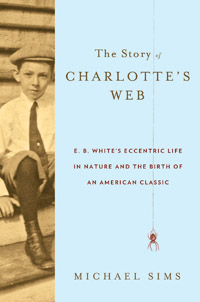A Love Letter to Charlotte
In his gorgeous new book, Michael Sims tells the story of how E. B. White came to write Charlotte’s Web
Since its publication in 1952, Charlotte’s Web by E.B. White has sold more than forty-five million copies and continues to be counted among the most beloved and bestselling children’s books of all time. In his beautifully written, thoughtful, and thought-provoking new book The Story of Charlotte’s Web: E.B. White’s Eccentric Life in Nature and the Birth of an American Classic, Michael Sims views the life of E.B. White through the prism of the classic he created.
White was famously reclusive and—strange as it may seem for a biographer—Sims understands and respects that need for privacy. Allowing White’s words and experiences to speak for themselves, he offers readers a deeper understanding not only of the life and mind that created Charlotte’s Web, but of the creative process that led to the book and of the sheer work it entailed. The Story of Charlotte’s Web is quite literally that: a biography of the book itself. How did it come to be? What forces and experiences throughout White’s life shaped him and converged to bring his timeless classic into being?
 Sims—a Crossville native and former Nashvillian—is the versatile author of well-regarded books such as Apollo’s Fire: A Day on Earth and in Imagination, Adam’s Navel: A Natural and Cultural History of the Human Form, and Darwin’s Orchestra: An Almanac of Nature in History and the Arts. His own affinity with nature and his talent for language are ideal tools for elucidating White’s work without the invasive, presumptuous psychoanalysis that too often plagues contemporary biographies. Early on in the book, Sims foreshadows the creation of Charlotte in his detailed description of the barn at White’s childhood home in Mt. Vernon, New York. Already, we learn, the child Elwyn Brooks White was absorbing elements of the natural world upon which his later writing would so strongly depend:
Sims—a Crossville native and former Nashvillian—is the versatile author of well-regarded books such as Apollo’s Fire: A Day on Earth and in Imagination, Adam’s Navel: A Natural and Cultural History of the Human Form, and Darwin’s Orchestra: An Almanac of Nature in History and the Arts. His own affinity with nature and his talent for language are ideal tools for elucidating White’s work without the invasive, presumptuous psychoanalysis that too often plagues contemporary biographies. Early on in the book, Sims foreshadows the creation of Charlotte in his detailed description of the barn at White’s childhood home in Mt. Vernon, New York. Already, we learn, the child Elwyn Brooks White was absorbing elements of the natural world upon which his later writing would so strongly depend:
In every corner of the stable, from stall planks near the ground to roof beams above the hayloft, different kinds of spiders spun their webs and waited for manna to fall into them. Some of the spiders were anonymous gray smudges in cobwebby corners, others elegantly patterned and displayed in the center of their web like a cameo in a necklace. All of the webs were wonderfully engineered and many were beautiful.
This is not a comprehensive biography; Sims condenses into a couple of chapters White’s entire career and body of work at The New Yorker and as a columnist for Harper’s magazine, for example. He rightly recognizes that previous books have explored White’s magazine career in depth. The narrative does unfold chronologically, however, with particular attention paid to White’s childhood in a bedroom community of Manhattan and to the farm in Maine where he lived and wrote as an adult. Suspense builds as Sims approaches the stage of White’s life when he began work on Charlotte’s Web, a stage, it must be noted, when many people begin to slow down. White began the book at age fifty, and it took three years to deliver it to his editor at Harper. Sims does the reader (and the attentive would-be writer) a favor by recounting the multiple drafts of the book, how its sections changed and moved, and how White stashed it away in a drawer more than once, each time for months on end, before deciding it was finally ready for an editor’s eyes:
 He set it aside for almost a year. While he incubated eggs and sheared sheep and mended fencing, while he corresponded with Jim Thurber and naturalist Edwin Way Teale and his old college buddy Howard Cushman, the manuscript sat in its box, growing as quickly as a kitten. Its images, its scenes and poetry, ripened in Andy’s mind and matured into better form.
He set it aside for almost a year. While he incubated eggs and sheared sheep and mended fencing, while he corresponded with Jim Thurber and naturalist Edwin Way Teale and his old college buddy Howard Cushman, the manuscript sat in its box, growing as quickly as a kitten. Its images, its scenes and poetry, ripened in Andy’s mind and matured into better form.
That period of time, an eon by today’s reckoning, may be the difference between a novel popular in its day and the classic we know. For it was after this particular fallow period that White decided to introduce Fern, and restructured the novel into its final form. Sims writes:
He had faith in clarity of expression even on those days when he lacked any other faith in life. Directness and honesty would carry the day, he believed, bringing alive the story whose mythological simplicity became more compelling for him every day. … The setting was now vivid in his mind. His characters were coming insistently to life. He was able to conjure the behavior of the creatures he dealt with every day. Helpless pigs, silly geese, clever spiders, greedy rats—Andy knew all of those characters.
When the book was published in 1952, among the early critics to recognize its brilliance was Eudora Welty, who noted in The New York Times that “As a piece of work it is just about perfect, and just about magical in the way it is done.” Welty was a writer who could appreciate the struggle of another writer to get just the right words onto the page in the right sequence. Charlotte’s Web was popular with children and with most critics from the very beginning, and White’s already considerable fame as a writer grew.
Three generations after the publication of Charlotte’s Web, fewer children grow up with barnyards and farm animals in their lives. So suburban and sheltered have the lives of many young people become that there is an entire movement (ironically playing out largely online) encouraging parents to raise “free range kids.” Sims helps us to understand how it is that White’s classic has endured, and will continue to do so, even in the age of relentless commerce and technology that pervades the lives of children today.
Michael Sims will discuss and sign The Story of Charlotte’s Web on July 16 as part of the Salon@615 series. Arrive at 10 a.m. for a free continental breakfast followed by the reading. To read Chapter 16’s interview with Sims about his own eccentric life in nature—and a sample from his memoir-in-progress—click here.


